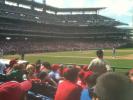|
Hall Of Famer
Join Date: Mar 2021
Location: Wilmington, Delaware
Posts: 2,913
|
1938 finds the nation emerging from the worst of the Depression. In Philadelphia, my Grandfather (presumably with a number of wealthy investors) has acquired the Phillies. He (and his investors) has (have) decided to upgrade the Baker Bowl, rather than abandon the venerable ballyard for Shibe Park (as the IRL Phillies did in mid-year 1938). Better yet, they have persuaded the City of Philadelphia to grant them an easement to extend the RF wall back about thirty feet, using the sidewalk on the west side of Broad Street. To accommodate the stadium wall blocking the sidewalk, clever engineers built a tunnel under the field. (Not so unusual for this spot, as several railroad tunnels run under the field area already, and the Pennsylvania Railroad's North Philly Station is directly across the street.) That means that the new dimensions in RF are: 311 feet down the line; 338 feet to RF; and 374 to RCF. The ugly forty-foot fence and its Lifebuoy sign ("The Phillies Use Lifebuoy Soap" [and still stink]) has been torn down, replaced by a more modest 25-foot barrier. The new OOTP ballpark HR factor for LHB is now 1.035, down from 1.367 with the old dimensions of 280/300/325. Chuck Klein is not happy about this.
The other major change for MLB in 1938 is the end of the color line. All Negro League players became free agents. The AI has been slow to sign those players, perhaps because the ratings are artificially low for many stars. The Phillies struck early, signing Josh Gibson and Buck Leonardfrom the Homestead Grays. Looking to the future, Philly signed 21-year-old SS Ted Strong from the and 2B Willard Brown (22) from the Kansas City Monarchs,. (Unlike IRL, the Negro League teams are compensated for these players, and of course the Phillies have to negotiate a contract with the players involved.). For experience and depth, the Phils signed Roy Parnell (34) from the Philly Stars and OF Turkey Stearnes (37) from the Chicago American Giants. Later, during the season, the Phils promoted hard-throwing youngsters George Walker and Roy Welmaker (each formerly of the Homestead Grays) to their bullpen.
The great Oscar Charleston was signed as hitting coach, and the recently-retired Rabbit Maranville as bench coach, for Manager Chuckles Barnstorm.
All throughout the Spring, and into the start of the season, the Phils negotiated with representative of the great Satchell Paige, then 31 years of age, and at the top of his ability. Paige held out for a multi-year contract, and did not sign until he was guaranteed three years at $37,500 a year, the top salary in all of MLB. Satchell started slowly, but has rounded out at 5-4 in 11 starts, including most recently a win at Forbes Field against the league-leading Pittsburgh Pirates.
Another option for MLB teams in this era was raiding talent (for compensation) from the Pacific Coast League. On May 3, the Phils purchased the contract of 21-year-old Dominick DiMaggio from the San Francisco Seals, for whom he had hit .306/.369/.431 the year before, while playing RF. In 25 games at AAA, Dom is at .303/.352/.485 for the Wilmington Blue Sox.
And the Phils signed free agent Jumbo Brown, who quickly became their closer. Brown, aptly named at 6'4" and 295 pounds, had been released by the New York baseball Giants.
Through mid-June, the revamped Phillies are holding their own, at 27-27, fourth place, nine and a half games behind the league-leading Pirates. The New York baseball Giants have won eight games in a row, to close within three games of Pittsburgh. Arky Vaughn of the Pirates leads the league at .399 and RBI at 41. Mel Ott leads in home runs with 10.
Over in the American League, the Yankees at 34-21 hold a three-game lead over the Boston Red Sox and the Detroit Tigers. Wally Moses of the A’s leads in hitting at .374. Hank Greenburg leads in HR with 17 and RBI with 62 (in 56 games!).
__________________
Pelican
OOTP 2020-?
”Hard to believe, Harry.”

Last edited by Pelican; 11-12-2022 at 02:13 PM.
|